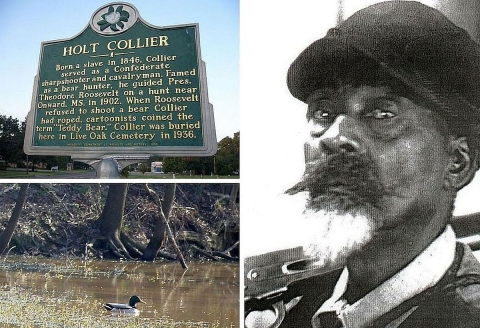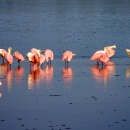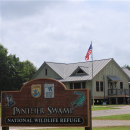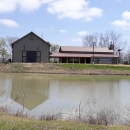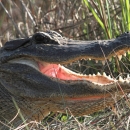About Us
Holt Collier NWR was established in 2004. The refuge was named for the legendary African-American hunting guide who led President Theodore Roosevelt on his famous Mississippi bear hunting trip.
Holt Collier, was formerly enslaved and served as a Confederate sharpshooter, cavalryman and spy during the Civil War. After the war, Collier’s knowledge of the wilderness, and his expertise in tracking game, made him a professional hunter. Collier’s prowess and reputation as a bear hunter became well-known.
The refuge lands have changed drastically over the years. In the early 1800s, for example, bottomland hardwood forest dominated the area. Today, more than 75 percent of the forest has been lost to agriculture, transportation, industrialization and urbanization. The plentiful black bear population all but disappeared too. Once prevalent across the Lower Mississippi River Valley, the Louisiana black bear, a threatened species, is found in only small sections of Louisiana, Mississippi and Texas.
Our Mission
Holt Collier National Wildlife Refuge is focused on providing healthy forest ecosystems for migratory and resident wildlife.
Our History
Holt Collier NWR is the only national wildlife refuge named after an African-American sportsman. His legacy was defined by his role in helping former President Theodore Roosevelt on a famous bear hunt in Onward, MS. Collier had many other accomplishments that resulted in the naming of a refuge in his honor. Here’s a bit of his background:
Holt Collier was born in 1846. His parents, Harrison and Daphne Collier, were enslaved. Holt, reportedly, had 10 brothers and sisters. Their parents were also enslaved as house servants for the prominent Howell Hinds family at their Home Hill Plantation in Jefferson County, Mississippi. Holt spent his early years at Home Hill caring for the hound dogs. Holt sometimes joined Hinds on hunts. When Holt was 10, Hinds took him to another family plantation, Plum Ridge, to attend to Hinds’ son Thomas. Plum Ridge, located in Washington County, was rugged wilderness with stands of giant trees, thick cane, stinging insects, venomous snakes, alligators, wolves, panthers, and bears. One of Holt’s primary duties was to provide meat for the plantation’s workers. He hunted with a 12-gauge shotgun, became an excellent marksman, and could shoot equally well from either shoulder. He shot his first bear at age 10. Holt was only 14 when the Civil War started and he joined the Confederacy by stowing away on a boat from Vicksburg, MS in a bid to follow his former master, Howell Hinds, and his son, Thomas. He then joined Company I of the Ninth Texas Cavalry, saw frequent action, and served as a military spy. He was the only officially recognized African-American to fight for the Confederacy in a Confederate uniform.
After the war, Holt became a Texas cowboy, but soon returned to Mississippi to live most of the rest of his life around Washington County and Hinds County, named for his former master’s family. Holt became well-known for his bear-hunting prowess and is credited with killing over 3,000 bears – more than all the bears taken by Daniel Boone and Davy Crocket combined. It was the pursuit of black bear that brought President Roosevelt to Mississippi in 1902 and into the field with the 56-year-old Collier. Holt’s unsurpassed expertise made the hunt a success even though the president would not shoot the large male bear that Holt single-handedly captured and tied to a tree. Roosevelt gave Holt a Winchester rifle by Roosevelt. The men hunted again in the future.
Word spread quickly of Roosevelt’s refusal to shoot the tied-up bear. The episode was publicized in editorial cartoons on the front page of the Washington Post. An enterprising New York store owner, Morris Michtom, saw the cartoon and created a stuffed toy he called “Teddy’s bear.” The popularity of the stuffed animal lead to the formation of the Ideal Toy Company. And, when the Teddy Bear turned 100 years old in 2002, Mississippi named it the official state toy.
Holt Collier died on August 1, 1936, at 90 years of age. He was buried at Live Oak Cemetery in Greenville, Mississippi near where he killed his first bear.
Other Facilities in this Complex
Holt Collier National Wildlife Refuge is one of nine refuges that make up the Theodore Roosevelt National Wildlife Refuge Complex. Each refuge in the complex plays vital role to conserving our nation's resources. A National Wildlife Refuge Complex is an administrative grouping of two or more Refuges, wildlife management areas or other Refuge conservation areas that are primarily managed from a central office location. Refuges are grouped into a complex structure structure
Something temporarily or permanently constructed, built, or placed; and constructed of natural or manufactured parts including, but not limited to, a building, shed, cabin, porch, bridge, walkway, stair steps, sign, landing, platform, dock, rack, fence, telecommunication device, antennae, fish cleaning table, satellite dish/mount, or well head.
Learn more about structure because they occur in a similar ecological region, such as a watershed or specific habitat type, and have a related purpose and management needs. Typically, a Project Leader oversees the general management of all Refuges within the complex and Refuge Managers are responsible for operations at specific Refuges. Supporting staff, composed of administrative, law enforcement, Refuge manager, biological, fire, visitor services, and maintenance professionals, are centrally located and support all Refuges within the complex.
Checkout the list below of the other Refuges within the Complex, and visit each one for new and different experiences!

